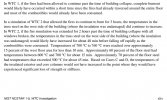As I understand it, the Towers were designed to absorb a suddenly applied gust of wind capable of moving the top (and all the mass that this implies) one foot outside of its footprint (and probably more).
You understand incorrectly.
The design wind load is not measured in feet of lateral replacement, and it being "suddenly aplied" does not enter into it.
The design load was merely a sustained wind speed (something in the "hurricane" spectrum), resulting in a particular lateral force on the perimeter as a whole, like a sail.
The specific danger of such a wind load, the way the tower would most likely fail if that load got exceeded, would have been an overloading of the perimeter on the side away from the wind (leeward) pretty low above ground.
I don't know how those forces compare. But I'm always happy to see some math to put it in perspective.
Upthread,
@benthamitemetric reproduced an excerpt from "City in the Sky" by James Glantz, which has the story of how come some engineers figured out that the towers would survive a plane hit: the calculated that a 707 at 600 mph would exert a lateral force that is maybe 30% higher than the maximum wind load the towers were indeed designed for - and that exceeding that by only 30% would probably be within the margin of safety. That's the result of the math done with slide rulers in the early 1960s, when it was utterly impossible the calculate the effect of multi-floor fires started by a plane crash and fanned by wind blowing through large gashes in the walls.
The other calculation they did was what would happen when you cut out perimeter columns along the width of the wings of a 707, and they found that there would be enough capacity for load redistribution around such a failure.
(I don't recall what the assumptions were wrt to where that hypothetical 707 would hit a tower, or what its mass would be, with fuel, cargo and passengers; a 707 is roughly the same size - wingspan and live mass - as a 767).
Both predictions proved to be correct.

